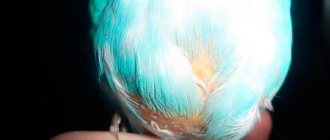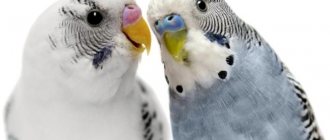Tumors are recorded in many animals, including parrots. Most often, neoplasms are found in older individuals. Most tumors in ornamental birds are benign in nature. Lipomas are the most common. A lipoma in a parrot can be located in almost any part of the body, grows quickly, compresses organs located near it and interferes with the normal functioning of the pet. Therefore, if you discover a wen, you should seek help from a specialist as soon as possible.
What is lipoma
Lipoma is a benign tumor consisting of adipose tissue surrounded by a connective tissue capsule. Lipoma in a budgerigar is most often located under the skin in the chest or abdomen, but can also be observed in other parts of the body. A benign lipoma does not form metastases, but causes discomfort to the bird and, as it grows in size, leads to the development of other diseases. In some cases, it can degenerate into a malignant tumor - liposarcoma, which is fatal.
Reasons for appearance
The reasons for the development of tumors are not completely clear. Among the factors contributing to the appearance of neoplasms from adipose tissue are:
- Lipid metabolism disorders. Their causes are hormonal disorders, diseases of internal organs, enzyme deficiency, as well as congenital genetically determined diseases.
- Incorrect feeding. Overeating and the presence of too many fatty foods in the diet lead to excessive accumulation of fat in the parrot's body. Violations of the feeding regime, when the bird starves for a long time and then receives a large portion of food, are also harmful.
- Sedentary lifestyle. If a parrot spends most of its time in a cramped cage and rarely flies, it develops obesity.
- Chronic stress, infectious and internal non-communicable diseases. They reduce immunity, which contributes to the development of tumors.
Team of Doctors
Internal varicose veins are very difficult to recognize in the initial stages. Therefore, everyone who has a genetic predisposition to this disease is recommended to undergo a preventive ultrasound at least once a year. Since the deep veins are surrounded on all sides by muscles, it is impossible to detect their deformation during visual inspection
On what parts of the body can it appear?
Normally, adipose tissue is evenly distributed throughout the bird’s body, but in case of abnormalities, it begins to accumulate in excess in one place. A lipoma is a tumor formed by adipose tissue of the subcutaneous fat, so it is almost always located directly under the skin. Most often, a tumor is observed on the belly of a budgerigar. In a parrot, the bump on the belly is usually located in its lower part, closer to the tail. Lipomas are also often found on the chest in the keel area. Bumps on the chest and abdomen can reach impressive sizes. Less commonly observed are bumps on the neck, back, pelvic limbs, bumps under the tail and on the wings of the parrot. Tumors can also develop on the head or under the wings.
In rare cases, lipomas are found on internal organs - liver, spleen, ovary. Typically, these tumors develop as a result of hormonal imbalances, as well as serious disorders of lipid metabolism, leading to the growth of adipose tissue around internal organs.
Diagnostics
In the early stages, lipoma does not affect the well-being and behavior of the bird. An area of the parrot's body may become swollen; upon palpation, a dense ball with a smooth, uniform surface is revealed, which easily rolls under the skin. As the lipoma grows, the feathers above it move apart or fall out, and the skin becomes yellow, mustard, or brownish in color. The bird's general condition worsens: it becomes lethargic, drowsy, loses its appetite, and drinks frequently. If the tumor is located on the wing, the parrot stops flying. If the lipoma is localized in the chest area, the bird has difficulty breathing. The formation of lipomas on the head and pelvic limbs leads to problems with movement.
It is necessary to differentiate a lipoma from a liposarcoma: the latter is associated with the surrounding tissues and is motionless on palpation. A biopsy is performed to make a definitive diagnosis.
What does varicose veins of the foot look like?
At the very beginning of the development of pathology, one feels heaviness and fatigue in the legs by the end of the day. Next, aching pain may appear, a sensation as if the leg is bursting, and the foot swells. All these symptoms may go away on their own after rest. But you shouldn’t put off going to the doctor. If varicose veins of the feet are not treated at the initial stage, the disease will begin to progress. First, spider veins and spider veins will appear, then varicose veins will also affect large veins. At this stage, the pain becomes constant, the legs begin to swell more, and muscle spasms appear.
Treatment
Treatment should be prescribed by a veterinarian after an accurate diagnosis has been made. In the early stages, treatment for lipoma in a parrot is carried out by adjusting the diet and using medications. As a result, the tumor may significantly decrease in size or even disappear completely.
If the tumor cannot be treated, it is removed surgically. The operation is performed under general anesthesia; the skin is incised and the tumor is removed along with the capsule. The tissue surrounding the tumor is usually not involved. Lipomas, as a rule, have a poor blood supply and do not grow into nearby tissues, so the operation can be considered relatively easy.
Balanced diet
The parrot's diet is adjusted in such a way as to reduce the amount of fatty tissue in the bird's body and prevent the accumulation of fat. In this regard, all fatty foods are excluded from the menu, as well as foods high in protein: seeds, nuts, sprouted grains, eggs. Stop feeding vitamin supplements, with the exception of vitamin B12.
The proportion of fresh vegetables, fruits and herbs in the diet is increased. You can give steamed grain and porridge. The diet must contain mineral supplements. It is useful to give the bird infusions and decoctions from the seeds of milk thistle, coltsfoot, and golden whisker.
Medication method
You can treat a tumor in a parrot using the following medications:
- lipoic acid – normalizes cholesterol levels; used for 3 months with food;
- karsil – improves liver function; administered with food;
- carnitine – normalizes lipid metabolism and reduces the size of lipomas; administered with drinking water;
- Legalon 70 – normalizes fat metabolism, especially effective in the early stages of the disease;
- elkar – strengthens the immune system; used within 30 days;
- lipomin – promotes the disappearance of lipomas; used for 10-14 days;
- sarcomine – normalizes metabolism, improves immunity;
- ASD-2 – promotes tumor resorption.
Attention! Medicines should only be used after consultation with a veterinarian.
Lipomatosis in a budgie
From: Evgeniy Tel.: +791601 Message: Good day. How long ago was a tumor discovered in a bird?: 10 days ago Did you notice a change in the size of the tumor?: no did not notice Specify the color of the tumor: Skin color Is the tumor riddled with blood vessels?: No What does the tumor feel like?: Soft The tumor is fixed or “rolling” to the touch "under the skin?: More like rolling around. Does the temperature of the tumor differ from body temperature?: No Upload photos of the tumor in the form below: Yes Good afternoon, budgerigar, female, 8 years old, lives alone, not kept in a cage, sleeps only in cage at night, 2 large playgrounds, ladders, toys, parrot dummies. I discovered a tumor on my tummy, I’m in a good mood, I eat fiory grain mixtures, sometimes eggs, rarely fruits, my wife sometimes gives her molting feed when she sheds, she eats oats separately, once a day, and she eats a little of it after soaking it in water. She has a bathtub with a mirror at the bottom, lately she has been sitting in it as if she was hatching eggs, before that she threw herself on her hands and rubbed her butt on her fingers) Then she sat in the bathtub and sits there, we appear, she starts playing, pestering, misbehaving. Something worries us about this tumor, it doesn’t seem to be growing yet, but we were worried. We haven’t done an X-ray yet, but the doctor determined it looks like a Lipoma. We live in Monino, Moscow region, do you think we should drink lipomin? The ornithologist’s response: “I looked. At best, a lipoma. At worst, it’s a “matryoshka” situation, when an ovarian tumor is hidden under a lipoma. Therefore, you will immediately have several drugs: 1. Hepatovet (vet) - 0.1 ml per day. 2. Lipoic acid - 1/40 of a 20 mg tablet per day (can be diluted well with warm water, the diluted one is stored in a jar for 5 days, then make a new dilution. This is to drink for at least a month. 3. Prednisolone ampoule. 0.015 ml per day. 22 days so far. 2. Rigevidon (tablets) - 1/4 tablet in 4 ml of water, from there 0.04 ml once a day in the beak. Also 22 days. 3. Meloxicam (and there are both veterinary forms and people ) - dose 0.01 mg per day, the same 22 days. According to the mind - X-ray, at least lateral projection. Mandatory - scatological examination of the litter (assess the condition of the liver and pancreas). Reduce daylight hours, gradually, to 7-8 hours ( up to placing in a dark bathroom). Completely exclude eggs, complex vitamins (later only group B and vitamin C will be allowed), sprouts - FOREVER. Reduce affection - this provokes the release of sex hormones, and you don’t need it
Drugs harmful to the treatment of parrots
Good afternoon Eliminate points 3, Rigevidon, 3 from the treatment plan as they are extremely harmful to the health of your bird. Treatment should be with courses of lipomin and sarcomin, 10 grains each, for 1 month. One month one medicine, another month another medicine.
Sincerely, Vladimir Romanov
Prevention
In order for the parrot to remain healthy, it is necessary to properly maintain and feed it. The cage must be cleaned regularly, and the feeders and drinkers must be washed every day to prevent the development of pathogenic bacteria in them, which can lead to a decrease in the bird’s immunity. It is important to prevent your pet from hypothermia and overheating. The room where the parrot lives must have good ventilation.
Your pet should be fed balanced food with moderate fat content, avoiding overfeeding. To prevent obesity, the parrot is allowed out of its cage every day to fly freely, and is also offered various toys and exercise equipment.
The drug lipomin and where to buy it in St. Petersburg
—From: Sergey Tel.: +796071 Message: Good afternoon. The doctor prescribed the drug LIPOMIN to our parrot and immediately warned that this medicine is difficult to find, but it is produced by you. We do not live in Moscow, and it is difficult for us to get to you, but one of these days (Thursday, August 3, that is, tomorrow) we will be passing through St. Petersburg. Can you tell me which veterinary clinics or pharmacies in St. Petersburg carry your drug? Perhaps you collaborate with someone on an ongoing basis, or distribute Lipomin there through some network. We are afraid that if we search on our own via the Internet, we will not have time to find the drug in the city within 24 hours. Thank in advance. Best regards, Sergei.
Consultation with an ornithologist in the city on the Neva
Good afternoon You can purchase the drug lipomin at the Green Parrot bird hospital, which is located in St. Petersburg on Vasilyevsky Island on Kartashikhina Street 12. Also, at the same time, you can additionally consult with a bird doctor at the same address
Sincerely, Vladimir Romanov
YOU CAN GO BACK TO THE LIST OF DISEASES AND TREATMENTS FOR PARROTS
Bird Hospital "Green Parrot" - treatment of parrots and ornithologists in Moscow and St. Petersburg. Did you like the material?
Other types of tumors
In addition to lipomas, other diseases of a tumor nature occur in parrots:
- Xanthoma. This is a tumor consisting of adipose tissue, bright yellow in color with a pronounced vascular pattern. Most often, this tumor in a parrot is located on the wings or above the tail. The reasons for its development are injuries and excess fats and vitamins in the diet.
- Hernia. This is a protrusion of internal organs (for example, intestines) through a pathologically formed opening between the abdominal muscles while maintaining the integrity of the peritoneum and skin. Externally, a hernia is a soft sac of skin with thin walls. Most often it occurs in females due to frequent clutches.
- Cerebellar hypertrophy. It is characterized by a change in the color of the wax to dark brown and the appearance of growths on it. The causes of hypertrophy are hormonal disorders in diseases of the reproductive system or squamous cell carcinoma.
Why is reticular varicose veins considered a mild form?
Varicose veins of the lower extremities have a separate type - reticular varicose veins. It is common mainly among women and is considered a mild form of varicose veins because in this case only the thin veins dilate.
Reticular varicose veins are often called cosmetic, since the main symptoms are external manifestations in the form of spider veins on the calves and thighs. Reticular varicose veins occur most often due to wearing high-heeled shoes, severe physical activity and taking hormonal pills.
Despite the fact that reticular varicose veins are mild, they need to be treated to avoid possible complications. Treatment of pathology of this type is carried out with the help of ointments, gels, venotonic nature, drug therapy, laser. Traditional surgical operations performed with a laser, especially a scalpel, are very rarely used.








